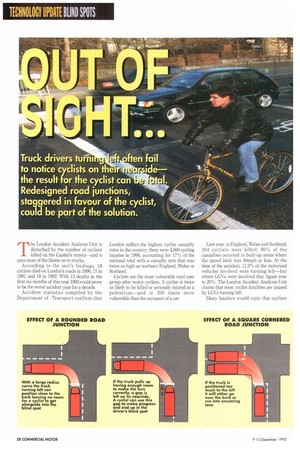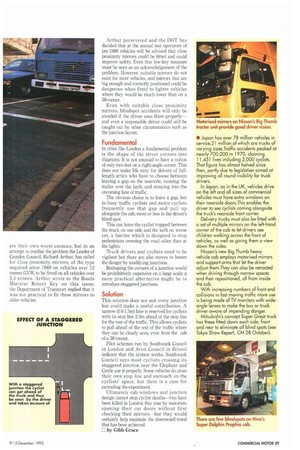T he London Accident Analysis Unit is disturbed by the number
Page 30

Page 31

If you've noticed an error in this article please click here to report it so we can fix it.
of cyclists killed on the Capital's streets—and it puts most of the blame on to trucks.
According to the unit's findings, 18 cyclists died on London's roads in 1990, 17 in 1991 and 19 in 1992. With 13 deaths in the first six months of this year 1993 could prove to be the worst accident year for a decade.
Accident statistics compiled by the Department of Transport confirm that London suffers the highest cyclist casualty rates in the country; there were 4,500 cycling injuries in 1990, accounting for 17% of the national total with a casualty rate that was twice as high as northern England, Wales or Scotland.
Cyclists are the most vulnerable road user group after motor cyclists. A cyclist is twice as likely to be killed or seriously injured as a pedestrian—and is 200 times more vulnerable than the occupant of a car. Last year, in England, Wales and Scotland, 204 cyclists were killed; 90% of the casualties occurred in built-up areas where the speed limit was 40mph or less. At the time of the accident, 11.3% of the motorised vehicles involved were turning left—but where LGVs were involved that figure rose to 20%. The London Accident Analysis Unit claims that most cyclist fatalities are caused by LGVs turning left.
Many hauliers would reply that cyclists are their own worst enemies, but in an attempt to combat the problem the Leader of Camden Council, Richard Arthur, has called for close proximity mirrors, of the type required since 1989 on vehicles over 12 tonnes GVIN, to be fitted on all vehicles over 3.5 tonnes. Arthur wrote to the Roads Minister Robert Key on this issue; the Department of Transport replied that it was not, practical to fit these mirrors to older vehicles. Arthur persevered and the DOT has decided that at the annual test operators of pre-1988 vehicles will be advised that close proximity mirrors could be fitted and could improve safety. Even this low-key measure must be seen as an acknowledgement of the problem. However, suitable mirrors do not exist for most vehicles, and mirrors that are big enough and correctly positioned could be dangerous when fitted to lighter vehicles where they would be much lower than on a 38-tormer.
Even with suitable close proximity mirrors, blindspot accidents will only be avoided if the driver uses them properly— and even a responsible driver could still be caught out by other circumstances such as the junction layout.
Fundamental
In cities like London a fundamental problem is the shape of the street corners (see diagram). It is not unusual to have a radius of only two feet on a right-angle corner. This does not make life easy for drivers of fulllength artics who have to choose between leaving a gap on the nearside, running the trailer over the kerb, and straying into the oncoming lane of traffic.
The obvious choice is to leave a gap, but in busy traffic cyclists and motor cyclists frequently use that gap and pull up alongside the cab, more or less in the driver's blind spot.
This can leave the cyclist trapped between the truck on one side and the kerb or, worse yet, a barrier which is designed to stop pedestrians crossing the road other than at the lights.
Truck drivers and cyclists need to be vigilant but there are also moves to lessen the danger by modifying junctions.
Reshaping the corners of a junction would be prohibitively expensive on a large scale; a more practical alternative might be to introduce staggered junctions.
Solution
This solution does not suit every junction but could make a useful contribution. A narrow (1.0-1.5m) lane is reserved for cyclists with its stop line 2-3m ahead of the stop line for the rest of the traffic. This allows cyclists to pull ahead of the rest of the traffic where they can be clearly seen, even from the cab of a 38-tanner.
Pilot schemes run by Southwark Council in London and Avon Council in Bristol indicate that the system works. Southwark Council says most cyclists crossing its staggered junction near the Elephant and Castle use it properly Some vehicles do cross their own stop line and encroach on the cyclists' space, but there is a case for extending the experiment.
Ultimately cab windows and junction design cannot stop cyclist deaths—two have been killed in London this year by motorists opening their car doors without first checking their mirrors—but they would certainly help maintain the downward trend that has been achieved.
E by Gibb Grace


























































































